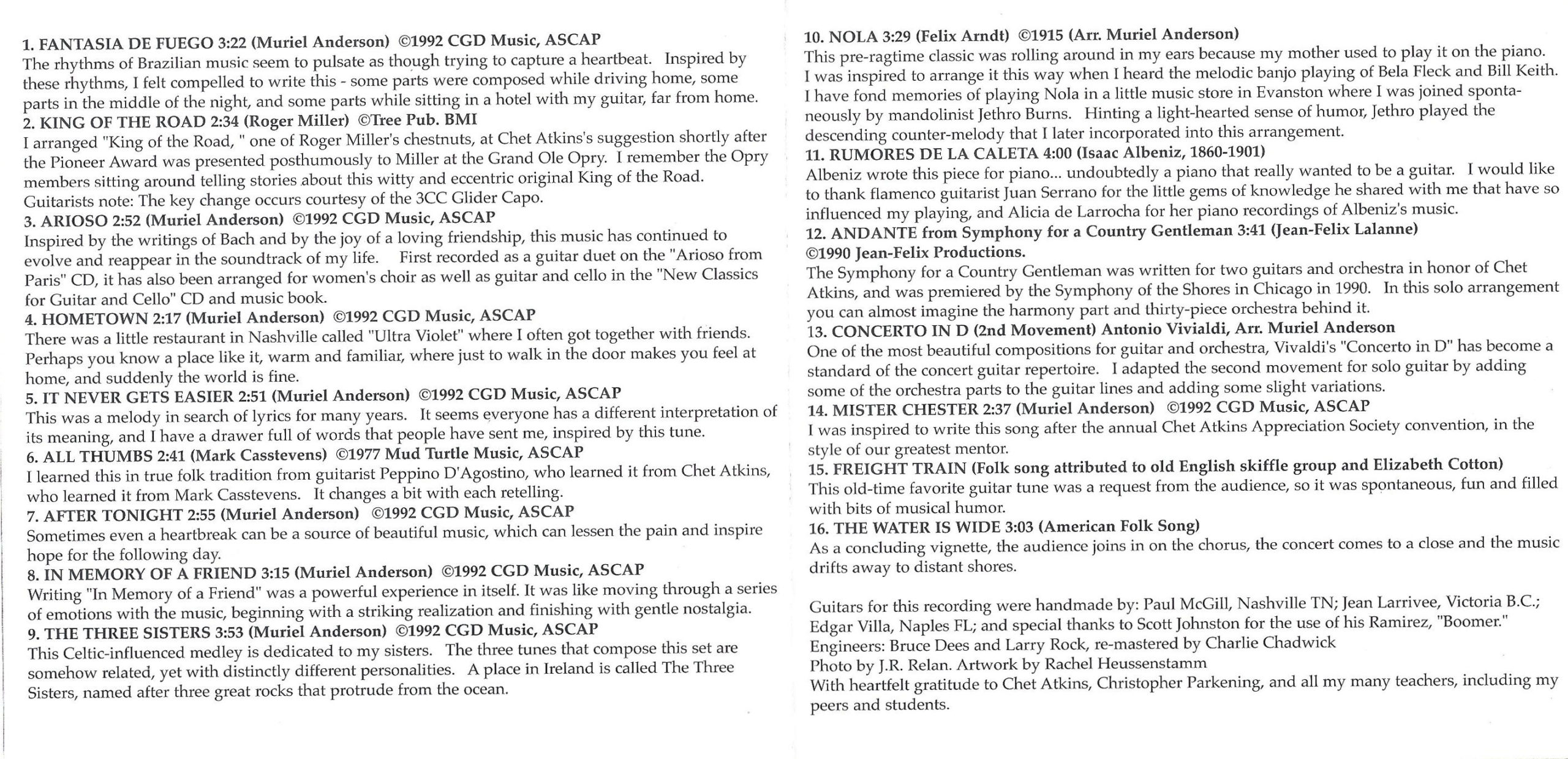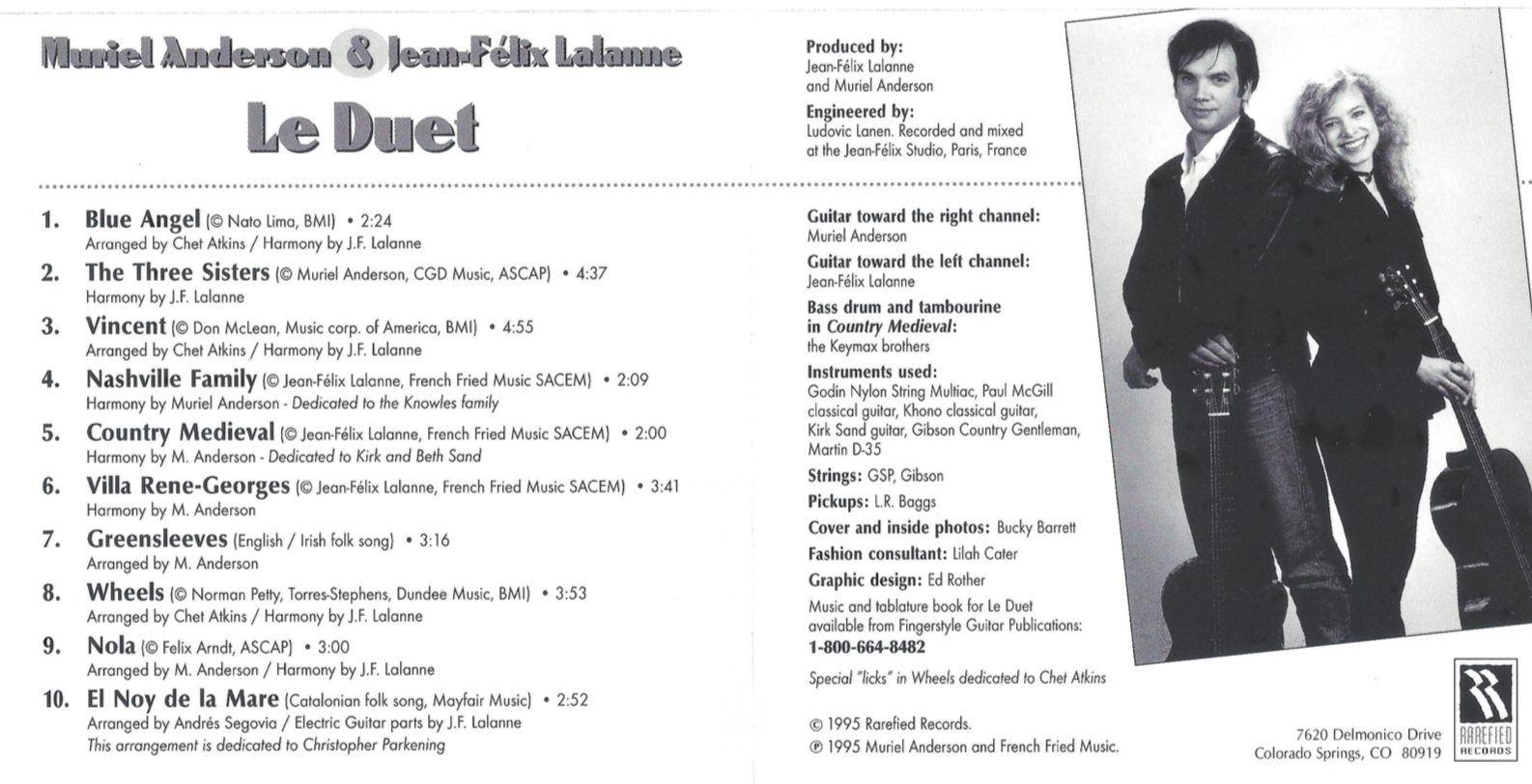Liner notes
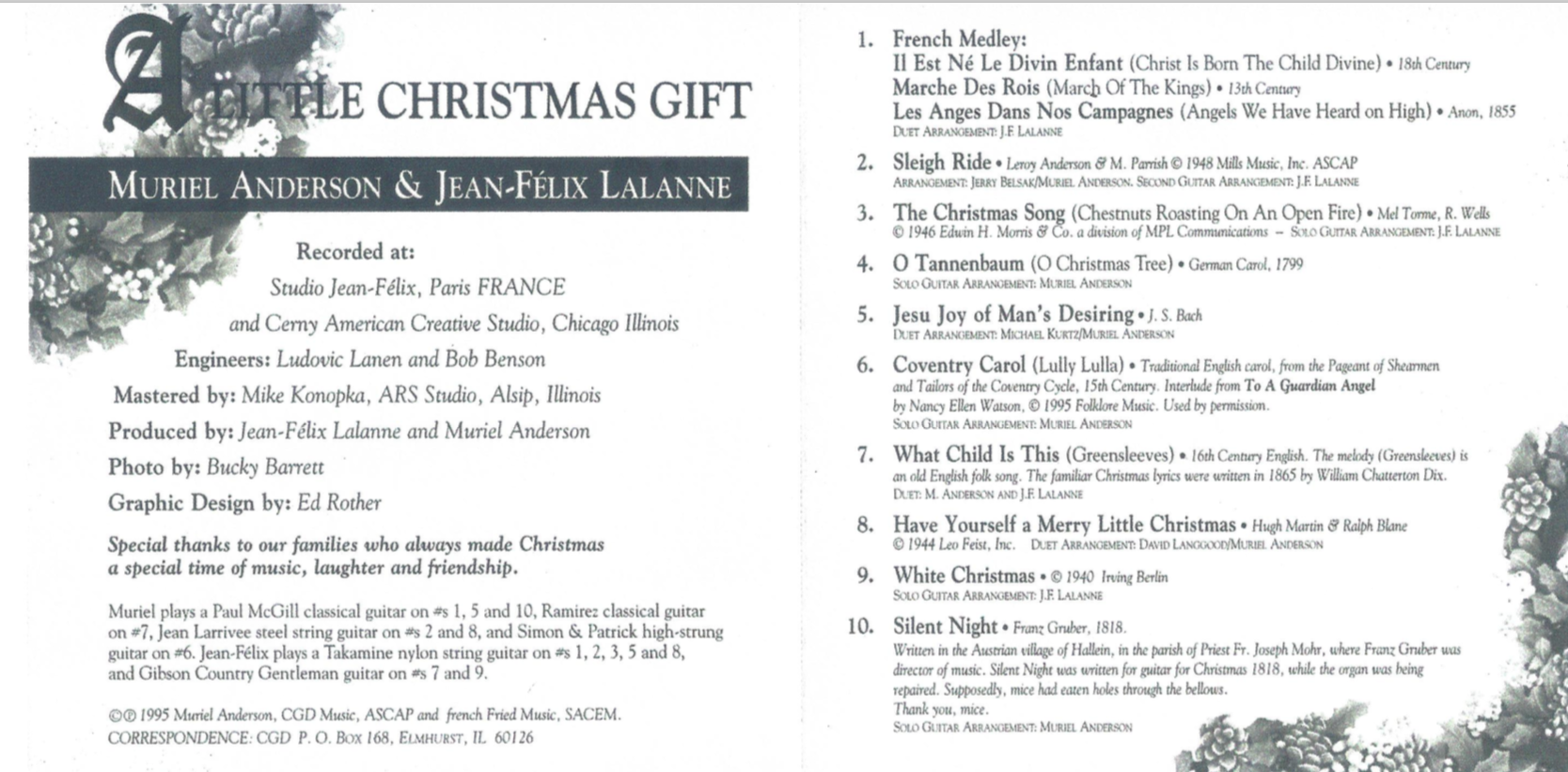
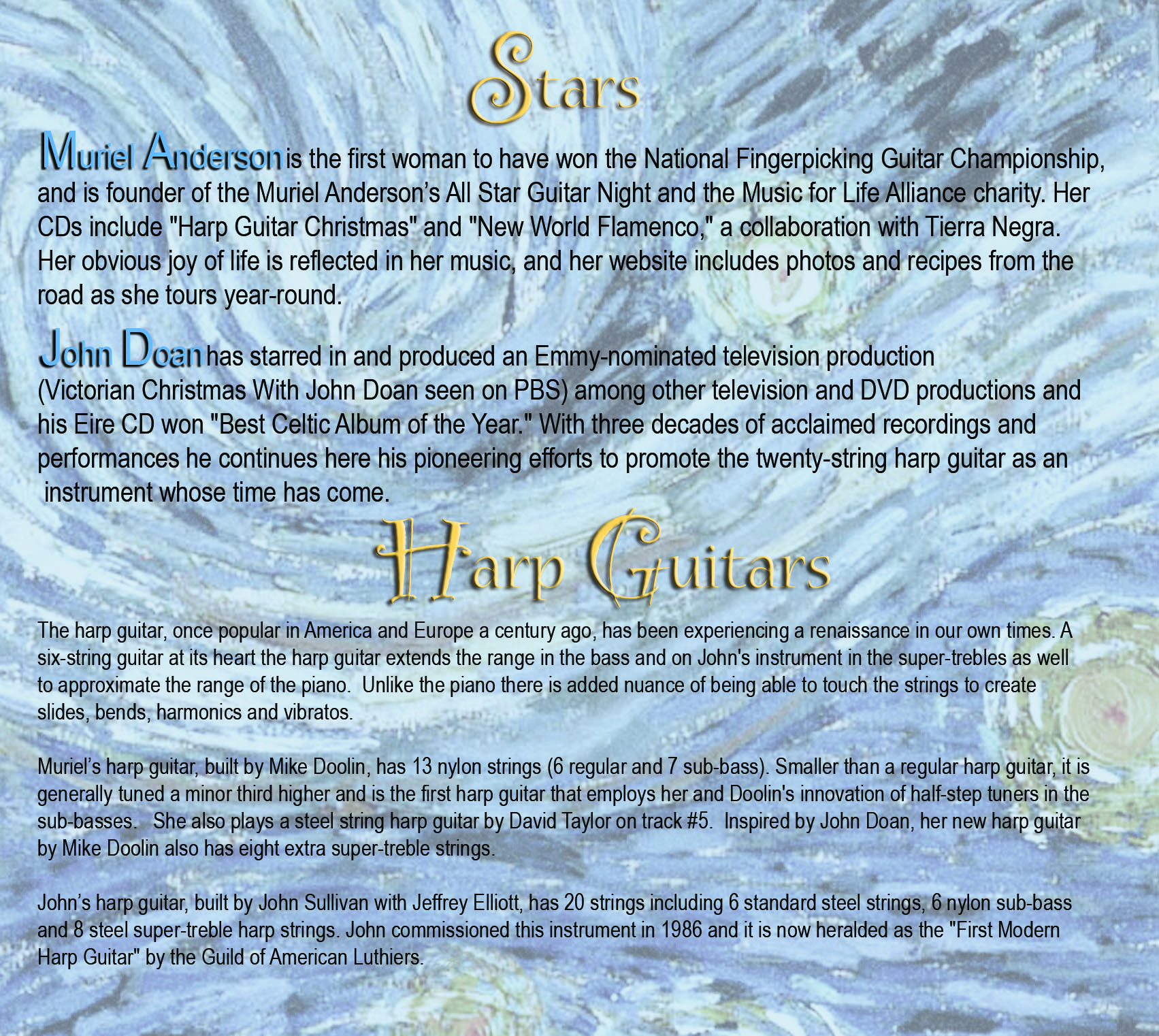
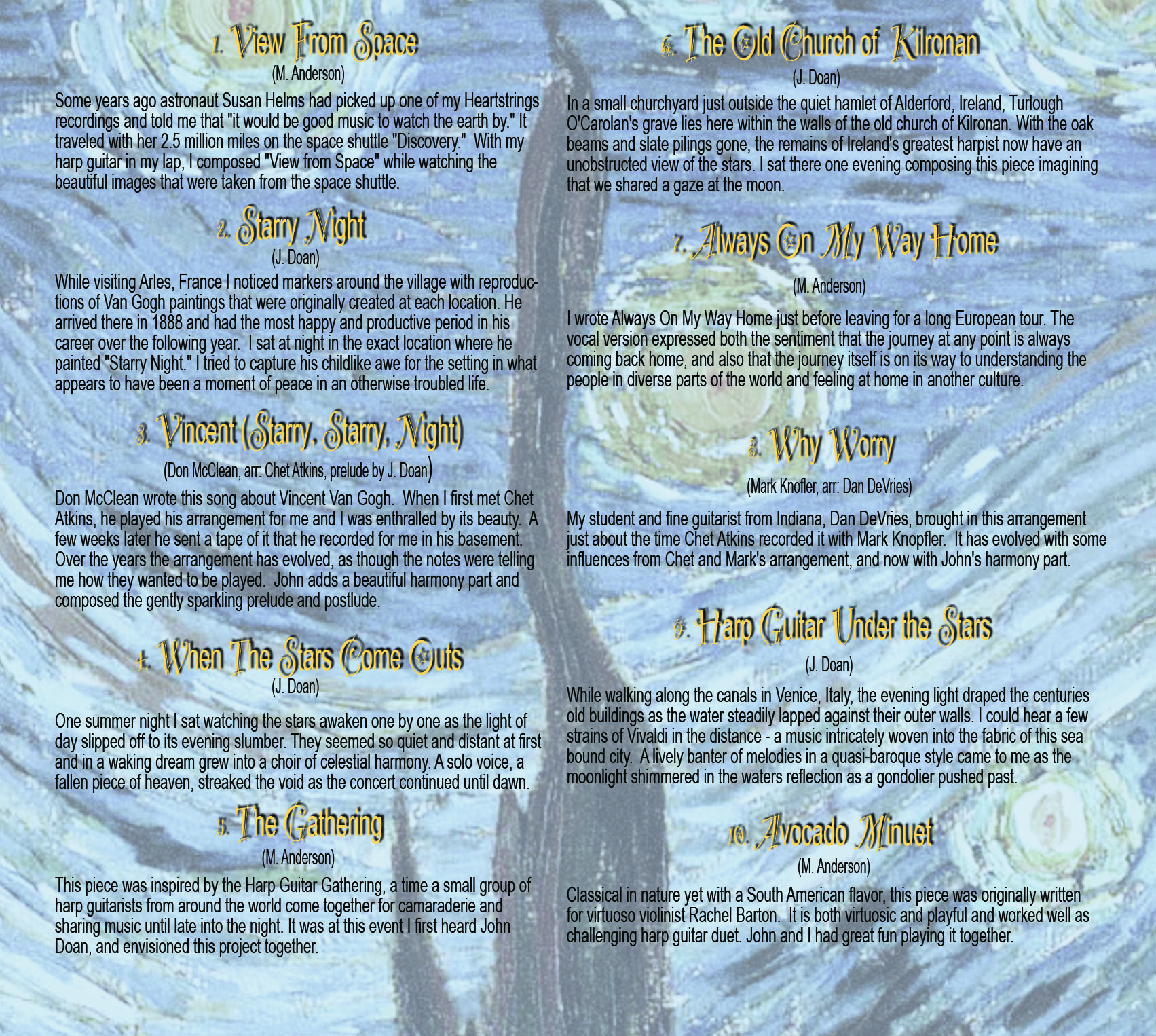

At the time of the recording’s release Muriel had just graduated from college, and was playing classical guitar in a hotel lobby. Convinced an audience existed for her music, she decided to record her favorite pieces. Heartstrings became one of the first solo guitar recordings to encompass such a wide variety of music. In 1993, astronaut Susan Helms took a Heartstrings cassette with her on a space shuttle mission, describing it as “good music to watch the earth by.”
- Nola (Felix Arndt) 2:46
- The Mysterious Barricades (François Couperin) 2:56
- Sakura (Trad. Japanese) 4:26
- Irish Medley 4:25 Shebig Shemoor (O’Carolan)Rosin the Bow (Trad.),The Twin Reel (M. Anderson), Saint Anne’s Reel (Trad.)
- Mr. Bojangles (Jerry Jeff Walker) 2:53
- Vincent (Don McLean) 3:48
- Cuban Lullaby (Trad./Leo Brouwer) 3:12
- Danza (Ruiz Pipo) 1:50
- Minuet No. 3 (J.S. Bach) 2:15
- Leyenda (Isaac Albeniz) 6:14
- Simple Gifts (Trad. Shaker) 2:09
- Hi-Lili, Hi Lo (Bronislaw Kaper) 2:41
- Peanuts Theme (Vince Guaraldi) 1:39
1. Nola, ©1915 Felix Arndt, Arr. Muriel Anderson When I arranged this work, I was intrigued by the cross-string melodic banjo playing of Bill Keith and Bela Fleck. While musing on whether this technique could be executed on the guitar, I heard my mother playing “Nola” on the piano. I found that the technique worked beautifully through much of the piece. Later I played my guitar arrangement of “Nola” for my mandolin teacher, Jethro Burns. Upon hearing my arrangement, Jethro said: “You have to meet my brother-in law.” Jethro and Chet Atkins had married identical twin sisters. The next time Chet came to Chicago we were introduced and Chet Atkins became a big influence in my music.
2. The Mysterious Barricades, Francois Couperin (1668-1733) from Couperin’s 6th suite for harpsichord, Arr. Christopher Parkening I began studying classical guitar in college only because there was no folk, bluegrass and jazz major offered at the university. It was at this time I heard the music of Christopher Parkening, one of Segovia’s youngest great protégées. I was amazed at the beautiful tone colors that he coaxed out of his instrument, and discovered a whole new world of technique and musicality. Mysterious Barricades has special appeal to me, as it is a bridge between two styles. It was composed for a harpsichord equipped with a lever that mutes the strings for two distinctive sounds . On the guitar, the effect is similar to Chet Atkins style.
3. Sakura, Traditional Japanese, Arr. Muriel Anderson, inspired by arrangements by Yukihiro Yoko-o and John Williams. “Sakura,” or “Cherry Blossom” is one of the most popular folk melodies in Japan. One of Parkening’s students, Seigo Yamada, was giving me coaching before I went to Parkening’s master class. Seigo gave me sheet music to “Sakura,” and advised me, “To really understand how to interpret this music, one must first study Japanese flower arranging.” I did the next best thing – I went to a sushi restaurant. I noticed in the art, language, cuisine, and music, a sense of space mixed with complexity, and a certain refined, polite placement. When I added these qualities to the music and began imitating the sounds of a koto ensemble, my arrangement of “Sakura” started to come to life.
4. Irish Medley: Shebig Shemoor (O’Carolan), Rosin the Bow (trad), The Twin Reel (Muriel Anderson), Saint Anne’s Reel (trad), Arr. M. Anderson I learned St Anne’s Reel from a Norwegian banjo player I met busking in the streets of New Orleans. Together with his girlfriend on flute, we played for coins tossed into the guitar case by passersby for most of the afternoon. Afterward, she suggested that we’d made enough to buy groceries for quiche for the three of us and my friends. We were delighted when they offered a place to stay for the night, (an unoccupied former house of ill-repute, which they were helping to restore for a movie called “Pretty Baby”) as my fellow students and I had only enough money left for gas for the trip home to Illinois. We played music late into the night, and he taught me some old Celtic fiddle tunes, which I learned note-for-note banjo style on the guitar.
5. Mr. Bojangles, Jerry Jeff Walker, © 1968 Cotillion Music, BMI, Arr. Chet Atkins When I first met Chet Atkins after his concert at Orchestra Hall in Chicago, he sat down and played some tunes for me. After hearing him play Mister Bojangles, I told him that I’d love to learn his arrangement, as it leaves plenty of space to improvise a little each time. He replied “I’ll send you some music you can play at your hotel gig.” I didn’t think he was serious, but a few weeks later I received a tape in the mail of tunes he recorded in his basement for me, including “Mr. Bojangles,” “Vincent,” and “Hi-Lili, Hi Lo.”
6. Vincent, Don McClean, ©1972 Music Corp of America, BMI, Arr. Chet Atkins This is one of the arrangements that Chet Atkins recorded for me to learn. He arranged it in the key of G so that the melody could be played almost entirely in natural harmonics. Don McClean wrote the song about Vincent Van Gogh and in particular his painting “Starry Starry Night.” I play this instrumental version with a classical phrasing to stretch out the melody notes with the pathos of McLean’s words.
7. Cuban Lullaby (Duerme Negrita), Ernesto Grenet Wood & S. Skylar, ©1920, EMI, ASCAP, Arr. Leo Brouwer/Christopher Parkening, Harmony Part by Michael Kurtz This popular Cuban song has come into the fold of the classical guitar community with the addition of Leo Brouwer’s bridge section and Parkening’s romantic interpretation. A gentle harmony part is added to the end in this arrangement. The lullaby is from the point of view of a working mother in the countryside singing to her baby.
8. Danza, Antonio Ruiz Pipo ©1961 from the suite “Canción y Danza” This lively dance was written by the Spanish composer, while living in France and inspired by Irish music.
9. Minuet No. 3, J.S. Bach (1685-1750) From Notebook for Anna Magdalena BachOne day when my mother got her piano tuned, the piano technician left me a copy of the Notebook for Anna Magdalena Bach, a collection of pieces written as instructional piano music for Bach’s second wife. At first I dismissed them as learning pieces only, until I discovered the uncanny sense of balance in Bach’s composing. One piece in particular, Minuet No. 3, was exceptionally charming on the guitar, and it became one of my favorites.
10. Leyenda (Asturias), Isaac Albeniz (1860-1909) Leyenda (also called Asturias) was the first piece of classical guitar music I learned when I began my study at DePaul University. With many new techniques, it became a great vehicle for my new adventure in Spanish classical guitar. As “Leyenda” was originally written for piano, I picked up an old LP of pianist Alicia de Larrocha playing Albeniz, and it inspired my interpretation. Near the beginning of the second section, the piano plays a high shimmering chord, where the guitar transcription had only a single note. I found a harmonic chord technique to create the effect the piano had on the recording.
11. Simple Gifts, Trad. Shaker Hymn I had some time left at the end of my recording session, so I decided to improvise on my favorite Shaker hymn. As a child at a Quaker Meeting retreat, I have memories of walking through cornfields and hearing the strains of “Simple Gifts” being played on a wooden flute somewhere in the distance. The beautiful simplicity of the melody speaks for itself, without need for complex harmonies. When my students asked how I had arranged “Simple Gifts,” I broke the process down to its basics, and the result evolved into the book “Building Guitar Arrangements from the Ground Up” (Hal Leonard Publ.)
12. Hi-Lili, Hi Lo, Helen Deutsch & Bronislaw Kaper ©1952 EMI Robbins Publ., Arr. Chet Atkins I expand a little on Chet Atkins’s arrangement of “Hi-Lili, Hi Lo” from the old movie “Lili.”
13. Peanuts Theme (Linus and Lucy), Vince Guaraldi, ©1964, Fellar Publ., BMI, Arr. J-F.Lalanne/ M. Anderson Some evenings when I was playing at my hotel gig, people would come in to listen to the music, and I played a regular concert for them. On other evenings people would be focused on their dates or business meetings, oblivious to the fact that there was a musician playing for them in the room. On these nights, without the feedback from an audience, my hands and back would start to hurt. When I took Jean-Felix Lalanne’s arrangement of “Linus and Lucy” and modified the rhythms a little so that the bass line could pop out, people would smile, look up and notice that there was a live musician. Then I would come back to life too.
All of Muriel Anderson’s arrangements on this recording are ©1989 CGD Music, ASCAP. Guitar transcriptions/tab for many of her tunes are available on her sheet music page.
